sensor Lexus IS220d 2012 Owner's Guide
[x] Cancel search | Manufacturer: LEXUS, Model Year: 2012, Model line: IS220d, Model: Lexus IS220d 2012Pages: 609, PDF Size: 14.63 MB
Page 208 of 609
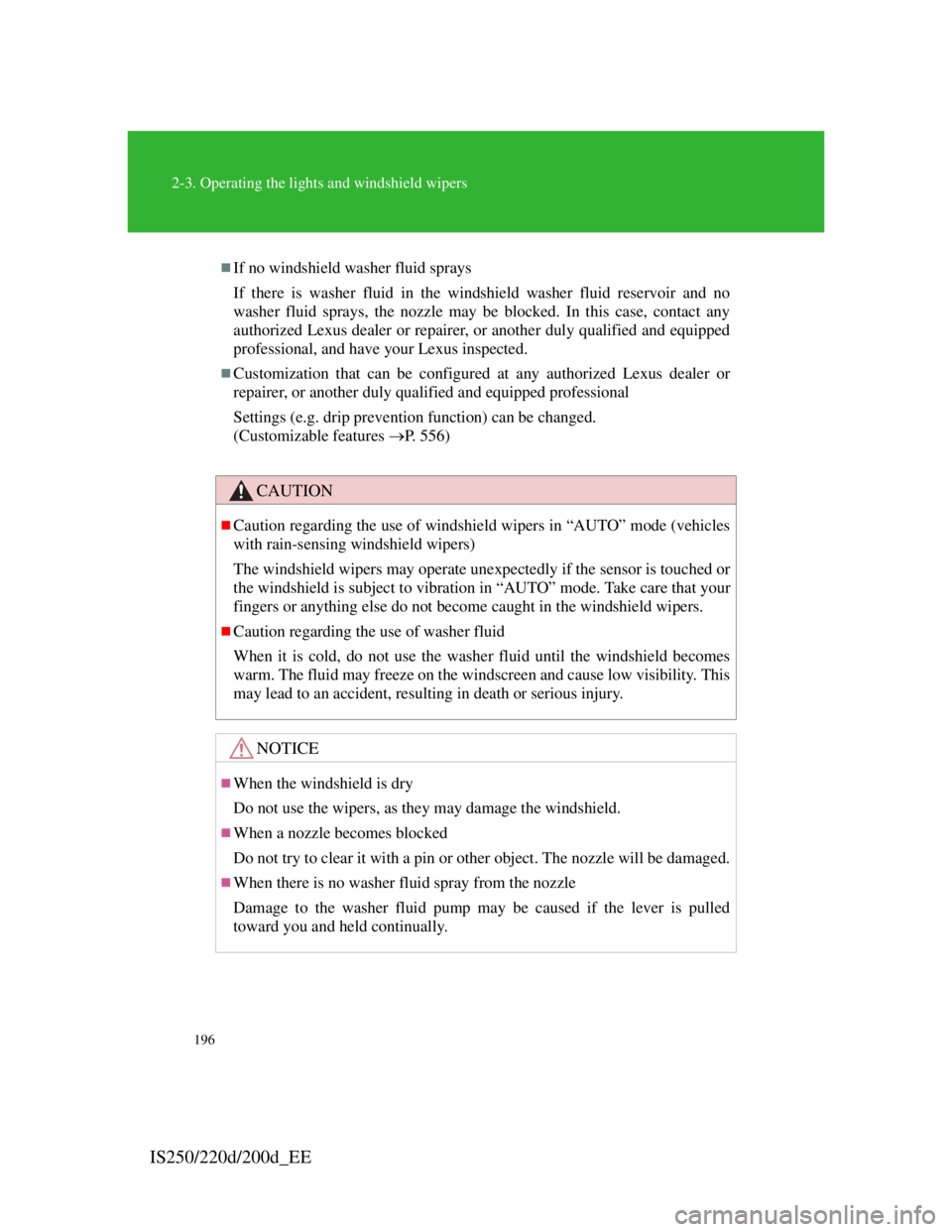
196
2-3. Operating the lights and windshield wipers
IS250/220d/200d_EE
If no windshield washer fluid sprays
If there is washer fluid in the windshield washer fluid reservoir and no
washer fluid sprays, the nozzle may be blocked. In this case, contact any
authorized Lexus dealer or repairer, or another duly qualified and equipped
professional, and have your Lexus inspected.
Customization that can be configured at any authorized Lexus dealer or
repairer, or another duly qualified and equipped professional
Settings (e.g. drip prevention function) can be changed.
(Customizable features P. 556)
CAUTION
Caution regarding the use of windshield wipers in “AUTO” mode (vehicles
with rain-sensing windshield wipers)
The windshield wipers may operate unexpectedly if the sensor is touched or
the windshield is subject to vibration in “AUTO” mode. Take care that your
fingers or anything else do not become caught in the windshield wipers.
Caution regarding the use of washer fluid
When it is cold, do not use the washer fluid until the windshield becomes
warm. The fluid may freeze on the windscreen and cause low visibility. This
may lead to an accident, resulting in death or serious injury.
NOTICE
When the windshield is dry
Do not use the wipers, as they may damage the windshield.
When a nozzle becomes blocked
Do not try to clear it with a pin or other object. The nozzle will be damaged.
When there is no washer fluid spray from the nozzle
Damage to the washer fluid pump may be caused if the lever is pulled
toward you and held continually.
Page 219 of 609
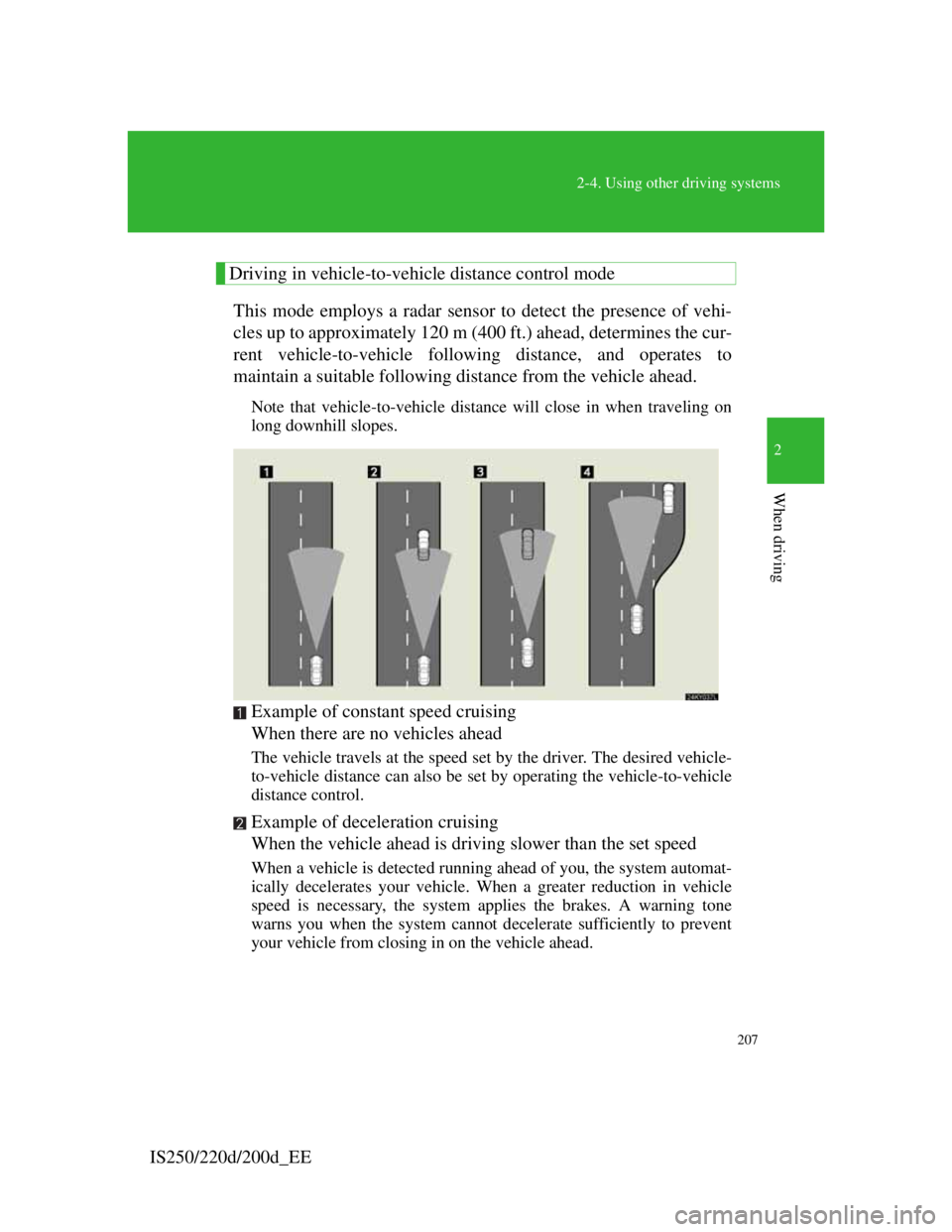
207
2-4. Using other driving systems
2
When driving
IS250/220d/200d_EE
Driving in vehicle-to-vehicle distance control mode
This mode employs a radar sensor to detect the presence of vehi-
cles up to approximately 120 m (400 ft.) ahead, determines the cur-
rent vehicle-to-vehicle following distance, and operates to
maintain a suitable following distance from the vehicle ahead.
Note that vehicle-to-vehicle distance will close in when traveling on
long downhill slopes.
Example of constant speed cruising
When there are no vehicles ahead
The vehicle travels at the speed set by the driver. The desired vehicle-
to-vehicle distance can also be set by operating the vehicle-to-vehicle
distance control.
Example of deceleration cruising
When the vehicle ahead is driving slower than the set speed
When a vehicle is detected running ahead of you, the system automat-
ically decelerates your vehicle. When a greater reduction in vehicle
speed is necessary, the system applies the brakes. A warning tone
warns you when the system cannot decelerate sufficiently to prevent
your vehicle from closing in on the vehicle ahead.
Page 222 of 609

210
2-4. Using other driving systems
IS250/220d/200d_EE
Adjusting the speed setting:
P. 2 0 4
Canceling and resuming the
speed setting: P. 206
Dynamic radar cruise control can be set when
The shift lever is in the D or range 4 or higher of S has been selected.
Range 4 or higher has been selected by using the paddle shift.
(vehicles with paddle shift switch)
Vehicle speed is above approximately 50 km/h (30 mph).
Accelerating after setting the vehicle speed
The vehicle can accelerate normally. After acceleration, the set speed
resumes. However, during vehicle-to-vehicle distance control mode, the
vehicle speed may decrease below the set speed in order to maintain the dis-
tance to the vehicle ahead.
Automatic cancelation of vehicle-to-vehicle distance control
Vehicle-to-vehicle distance control driving is automatically canceled in the
following situations:
Actual vehicle speed falls below approximately 40 km/h (25 mph).
VSC is activated.
The sensor cannot operate correctly because it is covered in some way.
The windshield wipers are operating at high speed (when the wiper
switch is set to the “AUTO” mode or the high speed wiper operation
position).
When snow mode is set. (IS250 only)
If vehicle-to-vehicle distance control driving is automatically canceled for
any other reason, there may be a malfunction in the system. Contact any
authorized Lexus dealer or repairer, or another duly qualified and equipped
professional.
Page 223 of 609
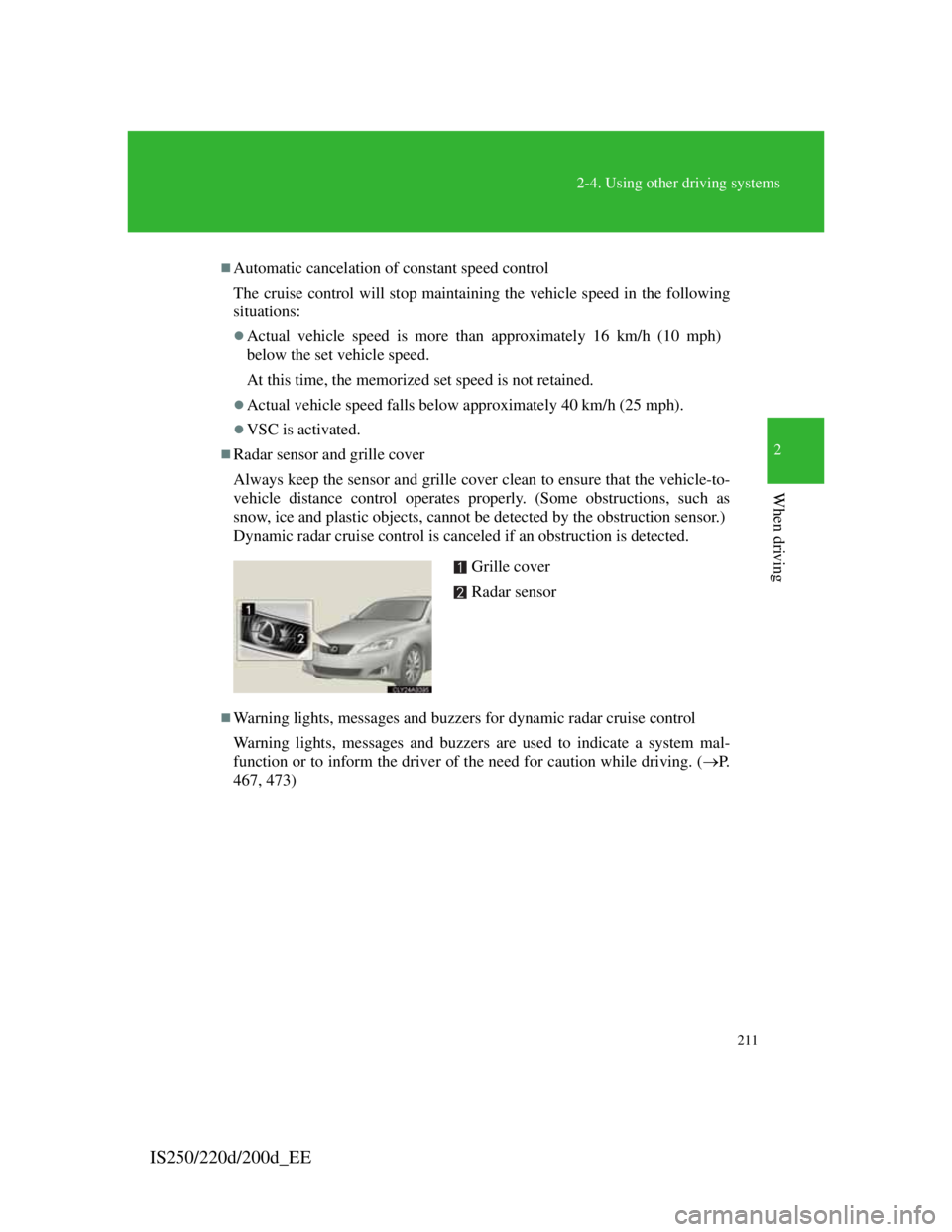
211
2-4. Using other driving systems
2
When driving
IS250/220d/200d_EE
Automatic cancelation of constant speed control
The cruise control will stop maintaining the vehicle speed in the following
situations:
Actual vehicle speed is more than approximately 16 km/h (10 mph)
below the set vehicle speed.
At this time, the memorized set speed is not retained.
Actual vehicle speed falls below approximately 40 km/h (25 mph).
VSC is activated.
Radar sensor and grille cover
Always keep the sensor and grille cover clean to ensure that the vehicle-to-
vehicle distance control operates properly. (Some obstructions, such as
snow, ice and plastic objects, cannot be detected by the obstruction sensor.)
Dynamic radar cruise control is canceled if an obstruction is detected.
Warning lights, messages and buzzers for dynamic radar cruise control
Warning lights, messages and buzzers are used to indicate a system mal-
function or to inform the driver of the need for caution while driving. (P.
467, 473)
Grille cover
Radar sensor
Page 227 of 609
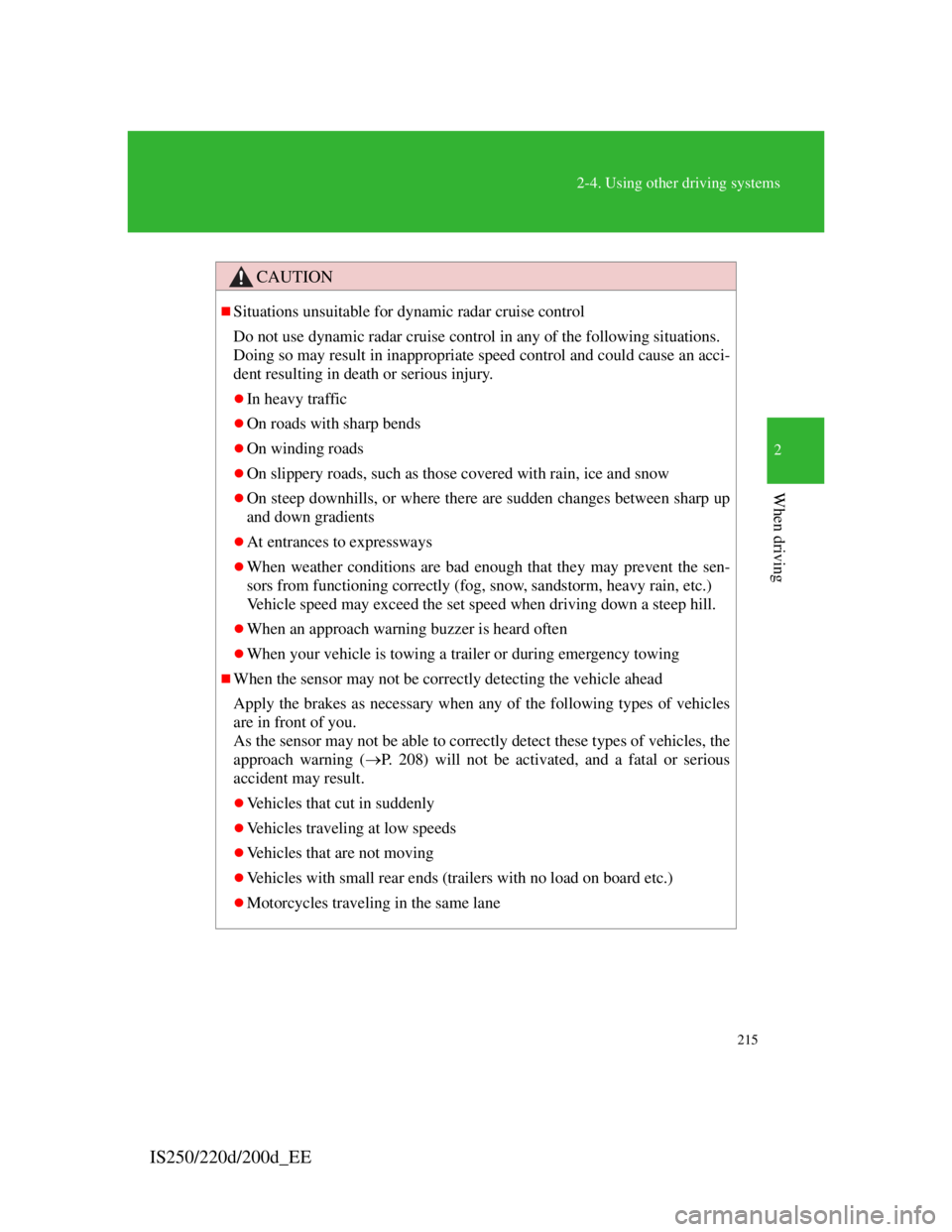
215
2-4. Using other driving systems
2
When driving
IS250/220d/200d_EE
CAUTION
Situations unsuitable for dynamic radar cruise control
Do not use dynamic radar cruise control in any of the following situations.
Doing so may result in inappropriate speed control and could cause an acci-
dent resulting in death or serious injury.
In heavy traffic
On roads with sharp bends
On winding roads
On slippery roads, such as those covered with rain, ice and snow
On steep downhills, or where there are sudden changes between sharp up
and down gradients
At entrances to expressways
When weather conditions are bad enough that they may prevent the sen-
sors from functioning correctly (fog, snow, sandstorm, heavy rain, etc.)
Vehicle speed may exceed the set speed when driving down a steep hill.
When an approach warning buzzer is heard often
When your vehicle is towing a trailer or during emergency towing
When the sensor may not be correctly detecting the vehicle ahead
Apply the brakes as necessary when any of the following types of vehicles
are in front of you.
As the sensor may not be able to correctly detect these types of vehicles, the
approach warning (P. 208) will not be activated, and a fatal or serious
accident may result.
Vehicles that cut in suddenly
Vehicles traveling at low speeds
Vehicles that are not moving
Vehicles with small rear ends (trailers with no load on board etc.)
Motorcycles traveling in the same lane
Page 228 of 609
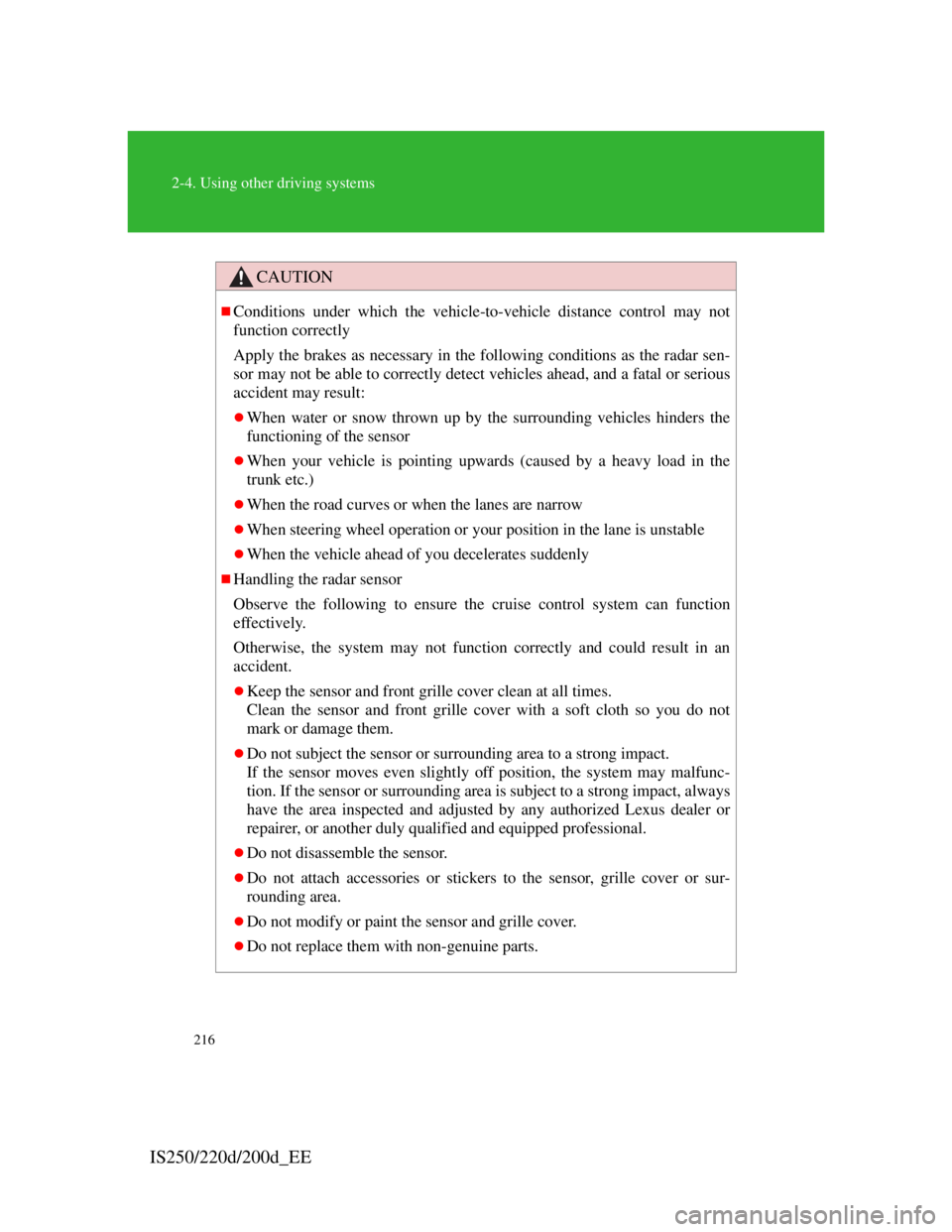
216
2-4. Using other driving systems
IS250/220d/200d_EE
CAUTION
Conditions under which the vehicle-to-vehicle distance control may not
function correctly
Apply the brakes as necessary in the following conditions as the radar sen-
sor may not be able to correctly detect vehicles ahead, and a fatal or serious
accident may result:
When water or snow thrown up by the surrounding vehicles hinders the
functioning of the sensor
When your vehicle is pointing upwards (caused by a heavy load in the
trunk etc.)
When the road curves or when the lanes are narrow
When steering wheel operation or your position in the lane is unstable
When the vehicle ahead of you decelerates suddenly
Handling the radar sensor
Observe the following to ensure the cruise control system can function
effectively.
Otherwise, the system may not function correctly and could result in an
accident.
Keep the sensor and front grille cover clean at all times.
Clean the sensor and front grille cover with a soft cloth so you do not
mark or damage them.
Do not subject the sensor or surrounding area to a strong impact.
If the sensor moves even slightly off position, the system may malfunc-
tion. If the sensor or surrounding area is subject to a strong impact, always
have the area inspected and adjusted by any authorized Lexus dealer or
repairer, or another duly qualified and equipped professional.
Do not disassemble the sensor.
Do not attach accessories or stickers to the sensor, grille cover or sur-
rounding area.
Do not modify or paint the sensor and grille cover.
Do not replace them with non-genuine parts.
Page 229 of 609

217
2-4. Using other driving systems
2
When driving
IS250/220d/200d_EE
Lexus parking assist-sensor
The distance to obstacles measured by the sensors is communicated
via the multi-information display and a buzzer when parallel parking
or maneuvering into a garage. Always check the surrounding area
when using this system.
With navigation system
For vehicles equipped with a navigation system, refer to the separate
“Navigation System Owner’s Manual” for further details.
Without navigation system
Types of sensors
Front corner sensors
Rear corner sensors
Back sensors
Multi-information display (P. 181)
Front corner sensor opera-
tion
Rear corner sensor opera-
tion
Back sensor operation
�
: If equipped
Page 230 of 609

218
2-4. Using other driving systems
IS250/220d/200d_EE
The distance display and buzzer
When a sensor detects an obstacle, the direction of and the approx-
imate distance to the obstacle are displayed and the buzzer sounds.
Front corner sensors
Multi-information
displayApproximate distance
to obstacleBuzzer
50 to 40 cm
(1.6 to 1.3 ft.)Medium
40 to 30 cm
(1.3 to 1.0 ft.)Fast
30 cm (1.0 ft.) or lessContinuous
Lexus parking assist-sensor switch (P. 365)
When on, an indicator is dis-
played to inform the driver
that the function is opera-
tional.
Page 231 of 609

219
2-4. Using other driving systems
2
When driving
IS250/220d/200d_EERear corner sensors
Back sensors
Multi-information
displayApproximate distance
to obstacleBuzzer
50 to 37.5 cm
(1.6 to 1.2 ft.)Medium
37.5 to 25 cm
(1.2 to 0.8 ft.)Fast
25 cm (0.8 ft.) or lessContinuous
Multi-information
displayApproximate distance
to obstacleBuzzer
150 to 60 cm
(4.9 to 2.0 ft.)Slow
60 to 45 cm
(2.0 to 1.5 ft.)Medium
45 to 35 cm
(1.5 to 1.1 ft.)Fast
35 cm (1.1 ft.) or lessContinuous
Page 232 of 609

220
2-4. Using other driving systems
IS250/220d/200d_EE
Detection range of the sensors
Approximately 50 cm (1.6
ft.)
Approximately 50 cm (1.6
ft.)
Approximately 150 cm (4.9
ft.)
The diagram shows the detec-
tion range of the sensors. Note
that the sensors cannot detect
obstacles that are extremely
close to the vehicle.
The range of the sensors may
change depending on the shape
of the object etc.